Van With Four Captain Chairs, Toilet in Back, Murphy Bed
Article by Outside Van tribe member, Tod Francis. Reposted from Medium.com
We have a 4×4 Sprinter van for adventure travel. We are asked about it daily; at trail heads, beach parking, campgrounds and gas stops. It seems many have "always wanted a van". This interest has increased with COVID as road trips have become more desirable. After having so many discussions about our van, I decided to put thoughts in a post to make it easier to share. Below are some observations about owning and designing a van based on our experience and build. This input is specific to adventure vans that are designed for storing gear and sleeping. Importantly,everyone has their own use case so you want to design for what your needs are.
Van Life and is it Right For You?
Van Life — I originally thought a van would be good for day trips with lots of gear and was not sure I'd want to sleep in it much. My son was more interested in multi-day camping trips. The minute we drove the van off the lot, we realized it opened up an entirely new way to explore. Traveling with gear, food and sleeping arrangements enables a new flow. You are no longer tied to itineraries, airplane flights, hotel deposits, or car rentals. Each day you can adjust travel and activities based on current conditions instead of plans made months in advance. We call it "going with the flow of the elements". There are many trips where we do a completely different itinerary than expected based on wind, waves, trail conditions, weather or smoke. We've had some adventures where we end up 700 miles away from where we expected. One trip we skipped Colorado spots to drive around thunder storms to ride the sunny MTB trails in southern Utah and hit two national parks that were not even on our minds the day before. Thats the beauty of van travel.
There are many other features to owning an adventure van, more than I can list, but here are a few. The main benefit is more time exploring outdoors. It is really nice to have your food, water, clothes and gear with you in one mobile space. You roll into a camp without putting up a tent or checking into a hotel. The spots can be on dispersed forest land, off 4×4 roads, fields, beaches and camp grounds. This provides a range of options and enables you to travel without advance bookings. You can pull up to rivers, streams or beaches you never heard of and those may be your best stops. If the weather turns nasty, you have a safe place to camp and can easily move.

I am often asked if having a van has taken away from our backpacking and other camping. I would say no, it just increases the amount we get outdoors. Backpacking is still our favorite outing but the van has improved the other types of adventure we might do. We spend less nights in hotels and more in dispersed forests. We park at trail heads in the winter for ski touring that we would not do out of a tent. Van sleeping is much easier and more comfortable than sleeping in a tent on the side of the road or in a campground. And the van provides a great launching point for backpacking.
Is an adventure van right for you? — There are many reasons to have a van butthey are not for most people. They are big, expensive, tough to maneuver, take up space in your driveway, and many can't make the time for road trips. Try to really think through if you will get enough use out of a van to justify the time and money you will put into the purchase. A good transition to a van is for those already living the adventure travel life with car/truck camping and are looking for an upgrade and more storage capacity. Many who think van life looks enticing but will keep staying in hotels may not get enough benefit from a pricey van. I know people who have purchased the dream van but a year later they have barely used it and sell it. After Covid cools down, I imagine we'll see quite a few used vans on the market. Typically those who really appreciate their vans already carry a lot of gear around and are comfortable camping or sleeping in your vehicle.
There are also other good options. The van designs I refer to are for adventure travel and gear hauling. If you are going to use your vehicle mostly for daily travel with gear, you don't need to spend the money on a custom van to accommodate sleeping, water, power, etc. A good option for this use case is a regular passenger van where all the seats fold into the floor. You can carry a lot of gear and they are easy to drive and park. Or, a pick-up truck with enclosed back for gear storage is much less expensive and quite versatile. A small RV or camper trailer might be a good option if a shower, bathroom, multi-burner stove and dining table are important. They can be much less expensive as well. Last, if you plan to use only a few weeks a year, renting a van or RV might make the most sense.
However, if your life style is right for an adventure van, then owning one can be awesome. Our van has changed the way we travel and explore. We have had many life memory trips in our van that would have never happened with normal travel. We love pulling up to a dramatic view, sliding the side door open and settling in. And, having our gear with us enables many adventures we might not be able to do otherwise.
Van Choice and Design Decisions
Assuming you are planning to go ahead with a van, below are some decisions and tradeoffs you will face. This feedback is based on our (and friends) experience from the road but may differ from your needs. Each topic could be a full post but have attempted a quick overview to help you get going.
Our Van and Use — We have a 2017 Mercedes Sprinter 170 4×4. We use it for adventure travel in the western US primarily for mountain biking, kite surfing, ski touring, and backpacking. We have been in 18 western states from Arkansas to Washington and many trips through British Columbia. We are a family of four including two grown children. We typically travel with 2 or 3 of us. We use it primarily for adventure travel and do not live in it. There are very different needs if you plan to live on the road.
We went to Outside Van, in Portland, OR to do our build. They provide a premium service and have a lot of experience having built out hundreds of vans. They are expensive but we have been very happy with the quality and follow up service. I do not have the skills or time to do it myself so that was not an option. I am sure there are many other builders out there but make sure they have done a lot of vans before as there is a steep learning curve in how to make it all work.
Instagram for our van and trips | Photos of our Van
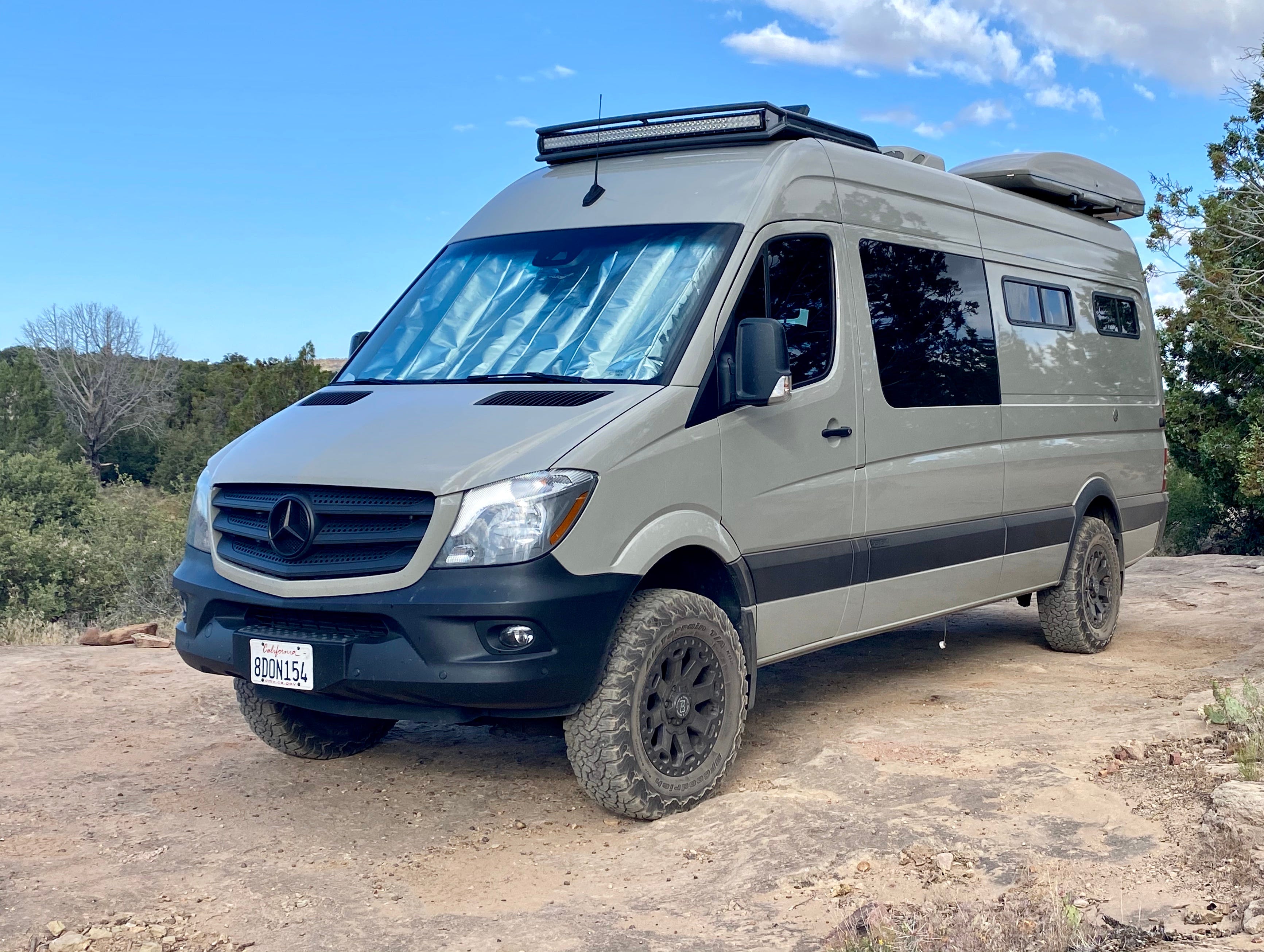
Design goals — Every decision is a tradeoff. More seating = less storage. More sleeping room = less open space. More water = less storage, etc. I strongly recommend todesign for your 80-90% use case. You will never be able to design for every scenario. The key drivers are 1) how many people do you need in seats, 2) do you plan to use as daily driver or primarily for road trips, 3) do you expect to sleep in the vehicle, and if so, how many people in most cases, 4) how much gear do you want to store inside. These elements will determine the choice of vehicle between the longer 170 and shorter 144 (more below on vehicle tradeoffs). Once a vehicle is chosen, then the primary decisions are around water, power, solar, storage, kitchen, seating and sleeping. More on each below.
Our design goals were 1) seating for 4 adults in comfortable seats with legal seat belts, 2) primary use would be adventure road trips and weekend outings, we do not use as a daily driver around town, 3) sleeping for 2–3, 4) carry a lot of gear, typically 2–3 bikes and 4–6 kite boards and kites inside the van. From here, we wanted to maximize power, water and open space in the van. We ended up with 4 captain chairs, large gear storage, bed for 2 with space on the floor for a third, 28 gallons of water, max battery storage, sink, refrigerator and lots of interior cabinets. Our finish is practical and simple.
Which Size Van is Right for You? — Different sizes serve different needs. I am only familiar with the Mercedes Sprinter. The shorter 144 is better for driving, parking and maneuverability around town. It is often preferred for one-two people especially if it is also a daily driver. The 170 has more room for storage, sleeping and seating. It drives well on the highway but can be tough in parking lots and around town. If you think the 170 is the right direction, you have another choice between the regular 4 wheel arrangement and the dually 6 wheel set. The dually provides more stability around corners and in wind but you lose interior space.
Your van choice depends on your primary use case. Since we use our van for road trips, we are thrilled with our 170 and would not consider a smaller vehicle. We have never wished we had less space although it is tough to park in tight spots. I know people who use the 144 in urban settings and for daily use and would not be happy with the 170. So it all depends.
4×4 — We use 4×4 frequently on fire roads to get to dispersed camping, accessing remote trails and winter driving for ski touring. It also provides a bit more clearance. 4×4 is more expensive so figure out if you really need it. It is absolutely worth it if you plan to go off road or drive over mountain passes in the winter.
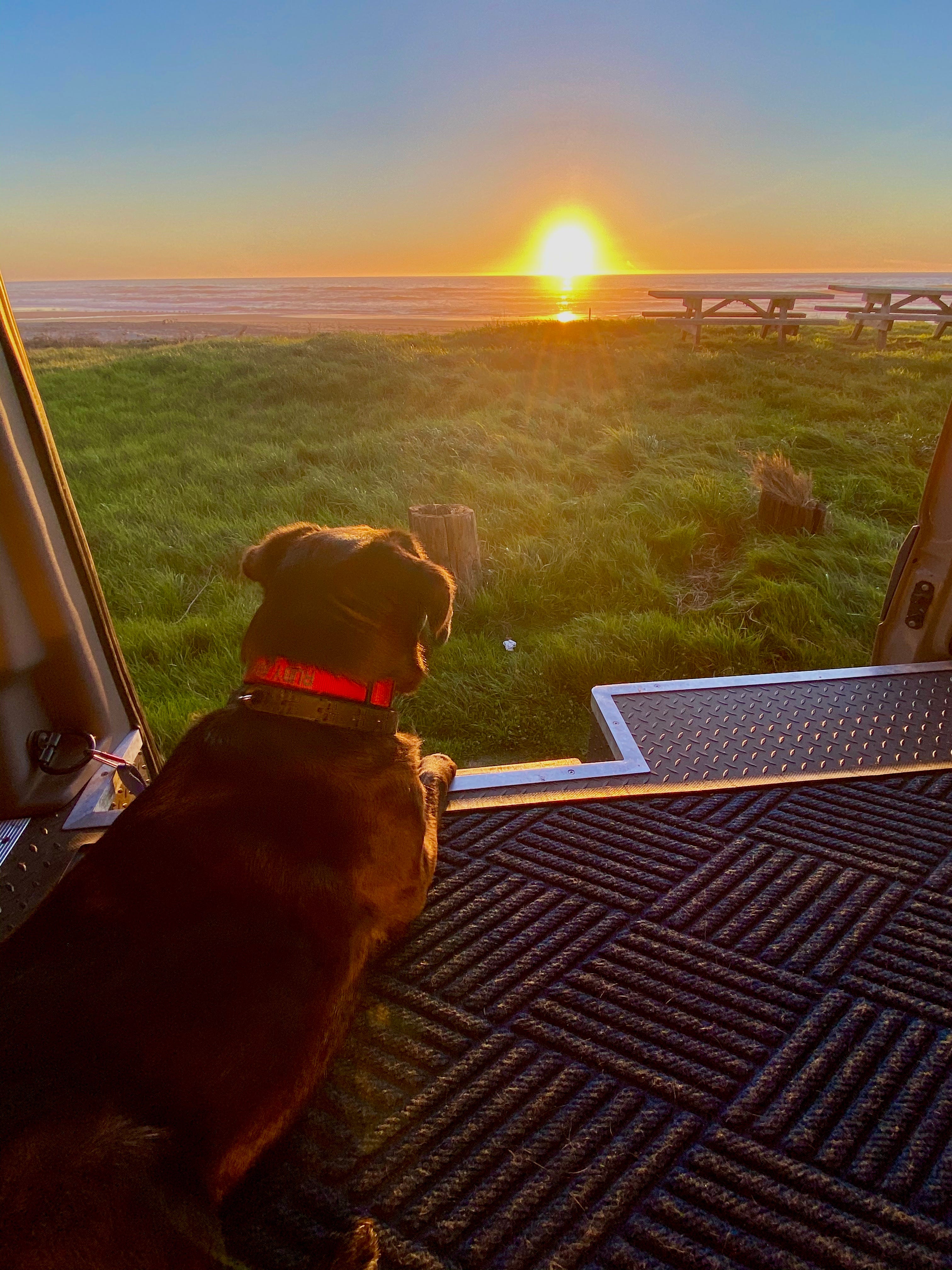
Interior Foundation — The foundation (flooring, ceiling, wiring, insulation) is key. The importance of this is often overlooked. Make sure your builder knows how to do this right. I often say the quality of our van is hidden. You want to have great insulation for climate control and sound. The wiring is very tricky to manage lights, power, stereo, etc. Another factor is the framing which determines where you can put holds to install shelving and other weight bearing items. Weight is an important variable as these vans get heavy so it is important to use weight efficient material in the foundation. In the main cabin, we have cloth walls and ceiling. This is great material for sound and warmth and is also lightweight. I've seen many vans that look good with wood and metal but I worry about the weight and flexibility to make adjustments later.
Seating — Your seating requirements will drive much of your design. If just two of you, everything is easy. If planning for three or more, then you need to design around a second row of seating. The second row of seating can be captain chairs or bench seating. I strongly recommend removable captain chairs so you can walk between them. You frequently move front-to-back in the van so having an opening helps a lot. If doing a bench seat, placing it back near the bed is a good way to retain some flow. However, many bench seating options are not DOT legal and likely not as safe. We placed our second set of captain chairs behind the galley so the van would have large open space where the side door opens. This was not typical but turned out to be a key decision. All the activity centers around the galley and open door. It is nice to have that area open for flow. A surprising benefit of this design is the rear seats are much quieter and don't have glare of seats up front. This makes for a much better setting for work, calls, reading and sleeping in transit. The rear seats feel like first class travel or can be the ultimate office setting.
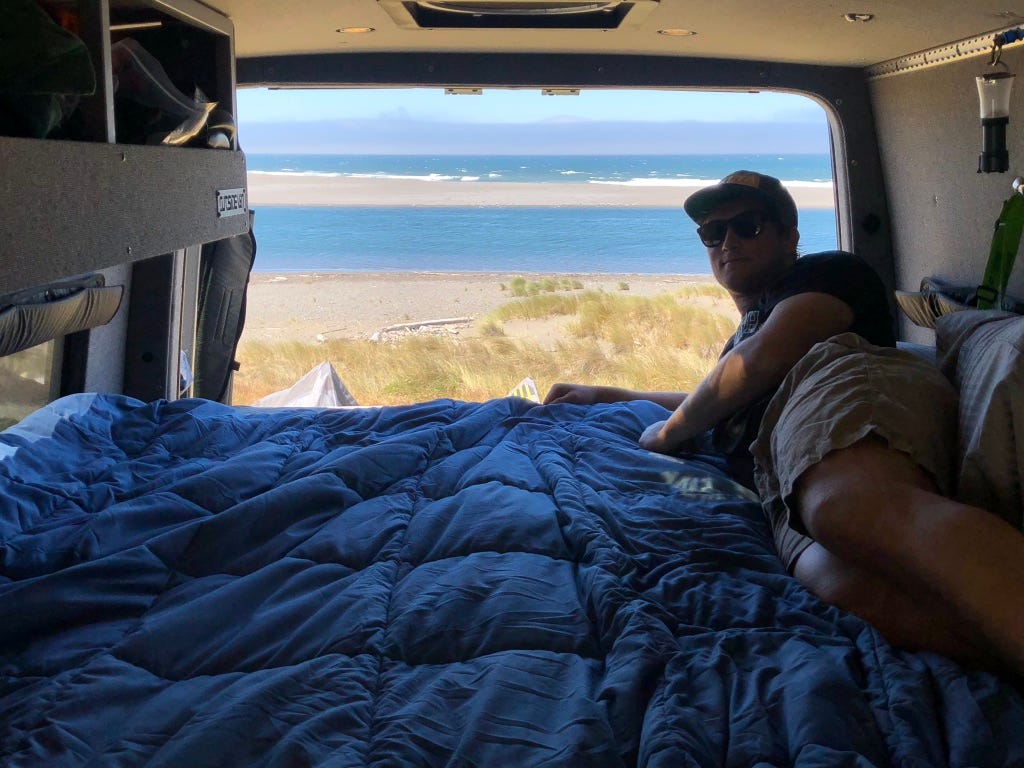
Sleeping — The largest use of space is often the sleeping area. I encourage you to design for the number in your most frequent use case. Trying to accommodate every scenario consumes a lot of space. Tents are cheap and easy to set up for overflow situations. We have a very comfy queen bed ideal for two with an additional space (and air mattress) on the floor for a third adult. If we had designed to sleep 4, there were tradeoffs with storage, seating comfort and open space. If we do have more than three, we pitch a tent next to van. Related to the sleeping area is gear storage which is typically below the primary bed. You want to set the bed height to maximize storage but allow enough room for sleeping below your cabinets. This is typically 38-39 inches. It is worth measuring your bikes or other gear in advance to figure out the ideal height. Last, try to have your sleeping surface removable so you can increase storage space for local gear hauling.
Power — Your power system is key if you plan to stay overnight or off the grid in your van. Simple rule of thumb is get as much battery storage as your space and budget will allow. The more you have, the more days off the grid. You use power for your refrigerator, fans, interior lights, computers, charging phones, and AC if you have it. It is nice to have a lot of solar but it impacts your roof design and takes away from storage capacity. We have 80W of solar to keep our main items going while off the grid. Our van has an extra, dedicated alternator to charge our batteries quickly while driving so we can typically recharge in a few hours. I understand new lithium batteries hold more power for the size which sounds great. However, there may be issues with lithium if you plan to use in cold weather. This is worth checking out.
Electrical Outlets — The most used outlets are USB charging areas next to each seat and back near the bed. We also have two 110V outlets for regular power, one near the galley and one near the back seats, which draw from our batteries or shore power. This layout works well.
Water — Having water on board is a nice benefit of owning a van. You will use for drinking, cooking, washing, showers, cleaning gear, etc. We have a 28 gallon capacity which gives us 3–4 days off the grid with regular use and more if very careful. Our dirty sink water runs straight out of the van so we do not collect grey water. This frees up space for other storage or more water. We have a soft, foldable bucket to collect our grey water if we are parked in a sensitive area which we can then spread in appropriate space.
Windows — Besides the views and light windows provide, they are are critical for air flow. Airflow is very important in the van for climate control and to keep it fresh. Make sure you have side windows in your van that have screens so you can leave open at night or daytime to enable air flow (not referring to front driving windows that you would not want to leave open). I strongly advise having at least two side windows that can be left open and enable cross draft. We have four side windows with screens which allows a lot of flow in the main area and back in sleeping area. I don't know if you need four, but two are necessary. Managing air flow and interior van temperatures is a constant activity. Trust me, it is important to pay attention to this in your design. See notes below on fans for more on air flow.
Window Coverings — These are important to keep your van cool and for privacy at night. The sun can bake your interior so we try to cover windows at every chance. At night, you want total coverage of light going out so you can camp in stealth locations. It is nice to have your windows installed with window covering fasteners so you can have good coverage.
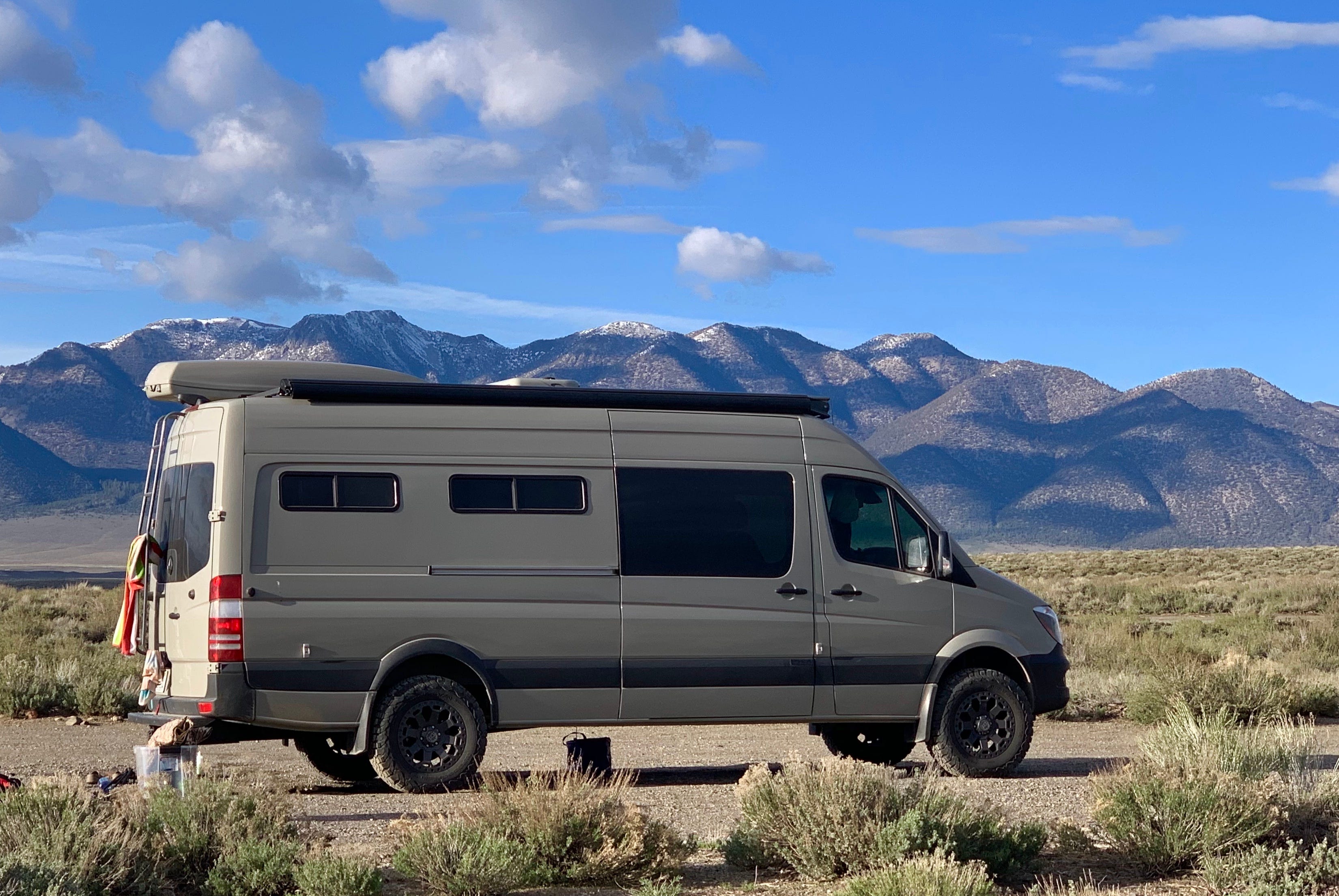
Fans — Our Maxxair ceiling fan is the most used item in the van. It creates air circulation in the van by drawing fresh air from the side windows. We use the fan even if we are not in the van, just to keep air flowing. They are also great for pets if they stay in the van for hours while you are out on an activity. Every van should have at least one ceiling fan. On longer vans, two can work well to increase flow throughout the interior. Some like to pull in with one fan, and blow out with the other to create a forced flow. We have two fans and not sure we need the second one which is further back over the bed so we use it less. A key consideration with fans is they impact the use of your exterior roof. The fan placement will impact the ability to have a storage box on top, where solar goes, and other storage up top. So think carefully about where you want to place your fan(s). I strongly encourage having one of them centrally located in a spot that is easy to access and near the cooking area.
Heater — A separate heater helps for temp control on colder nights and, importantly, keeping your van from freezing up. We have a Webasto heater that runs on a tiny amount of diesel fuel and does a great job of keeping the van warm. It has a setting for when we are not in the van where it will start heating to prevent the vehicle, water and pipes from freezing up. It heats our water for showers and sink use. We also use it to dry and warm ski boots and clothes. Make sure and place your heating vent in your main cabin area and not in your gear garage. I view a heater as one of the important luxuries of a custom van.
Refrigerator — Another key element of van life. It is nice to always have food available after activities on day use or fully stocking for camping. Our 4.6 cu in Isotherm (30×20″ inch) fridge has worked well for all our road trips. Our solar panel can keep the fridge powered and running while off the grid.
Sink — Yes, a sink is another van luxury. Great for washing, cooking, filling bottles, etc. Our water drains directly to the outside so we do not collect grey water (see water).
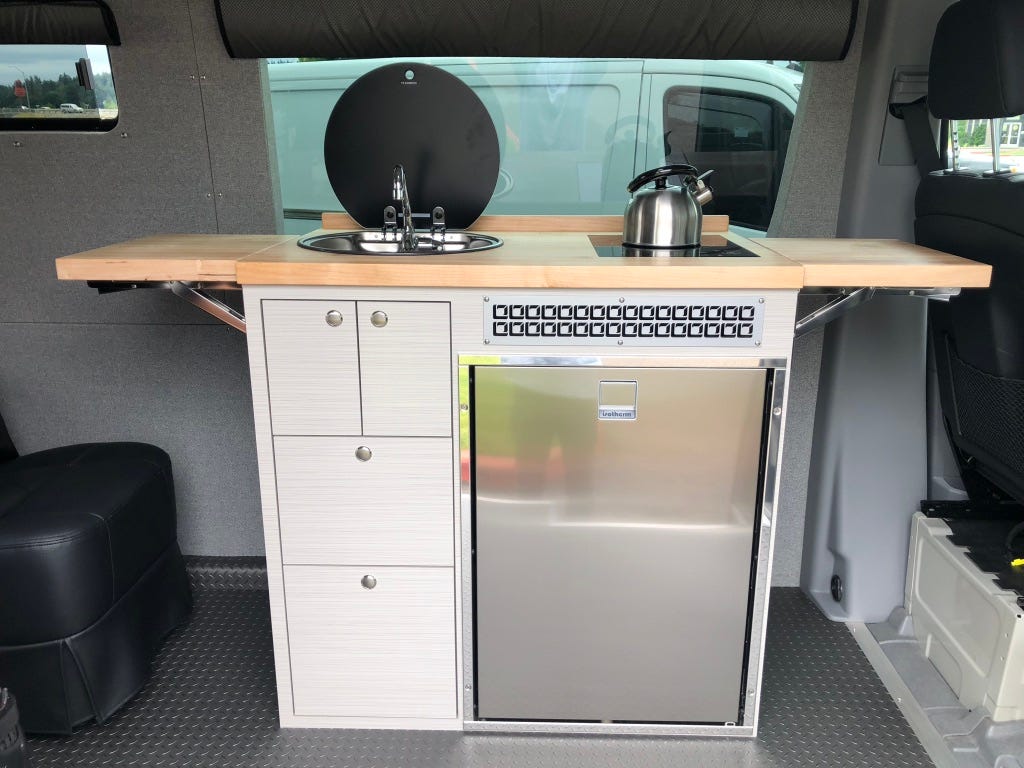 Built-in Stove — One of the hot debates is do you need stove inside? It's a toss up. Many feel they don't want to cook inside due to odor and want to save the space. Plus, it is easy to use a propane stove outside in most cases. We ended up with a built-in stove and are very glad we did. We also have a two burner propane stove we use outdoors. There have been many cases where it is raining or cold outside and we want to cook inside. Or, we may be in a rush, or arrived at our camping spot late, and can quickly prepare our meal. We have not had any odor issues as we have side windows and fans to help with circulation. We usually just open the side door while cooking which gives a lot of air flow. Having said that, a small propane stove works well and saves counter space for other needs.
Built-in Stove — One of the hot debates is do you need stove inside? It's a toss up. Many feel they don't want to cook inside due to odor and want to save the space. Plus, it is easy to use a propane stove outside in most cases. We ended up with a built-in stove and are very glad we did. We also have a two burner propane stove we use outdoors. There have been many cases where it is raining or cold outside and we want to cook inside. Or, we may be in a rush, or arrived at our camping spot late, and can quickly prepare our meal. We have not had any odor issues as we have side windows and fans to help with circulation. We usually just open the side door while cooking which gives a lot of air flow. Having said that, a small propane stove works well and saves counter space for other needs.
Microwave — Microwaves sound good but take prime cabinet space you can use for food or clothe storage. We do not have a microwave and glad we did not get one. We have never had the need for it and the storage space is precious. For some families, it might be a great choice. It all depends on the tradeoff of cooking ease versus storage.
Cabinets — Every inch of indoor storage is precious as you need room for clothes, food and camp items. We find the storage over the driver area plus a few cabinets works pretty well for 3 people. We use two cabinets over the sink for food, drawers for cookware, and each person has an overhead space for clothes. Some of our cabinets are removable (mounted on L track on side of wall) so we can configure for the number of people traveling.
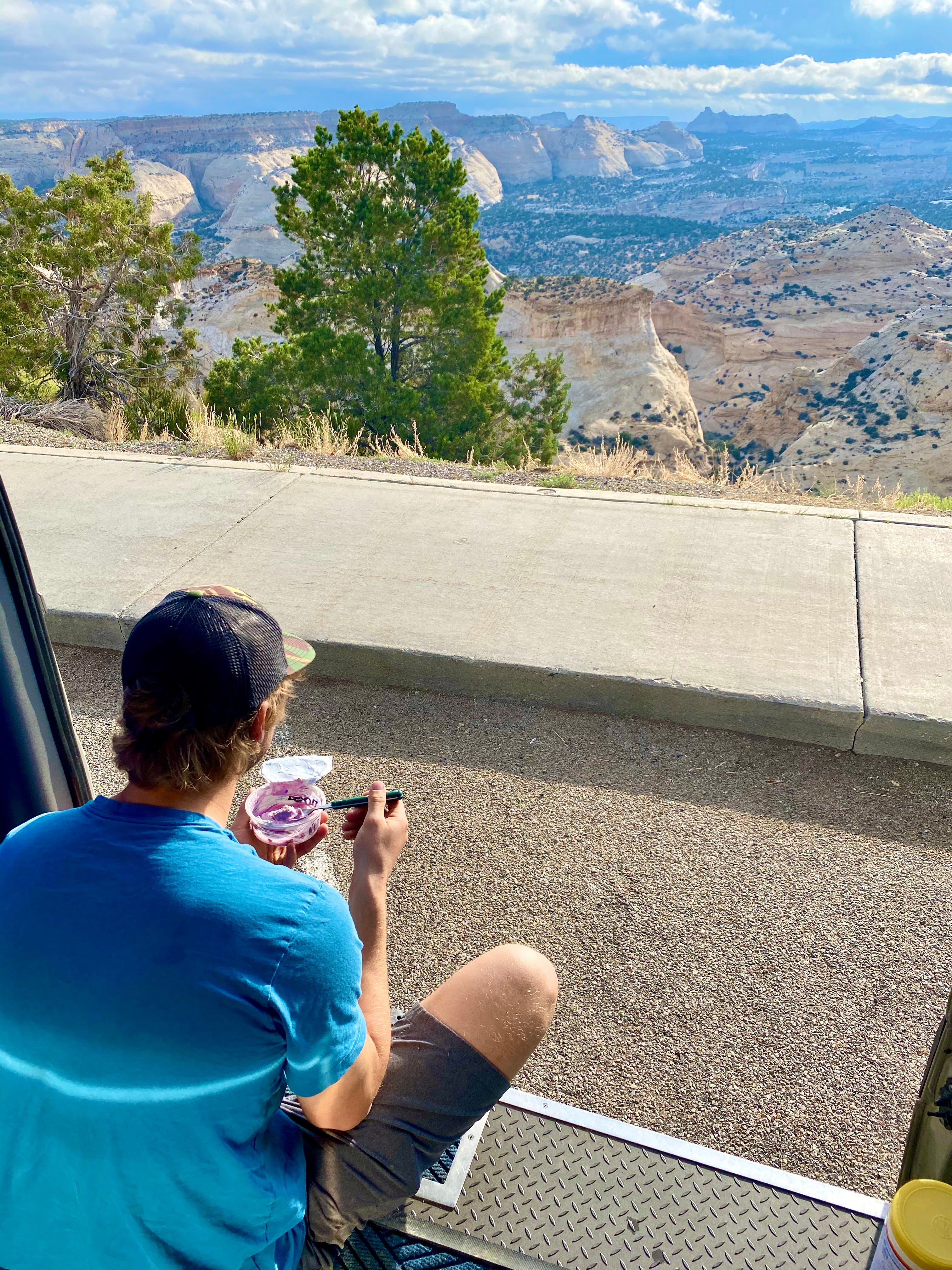
Open Space — Open space provides room to stand, move around, stretch and even sleep an extra person. We prioritized open space to be at the opening of the side door in front of the galley as this is where all the activity in the van is. It also enables views from all four chairs when the side door is open. I see many building out both sides of their interior for more features but they lose this important advantage. The open space really shines after you pull into your camp spot, its cold out, doors are closed and multiple people are eating and moving around inside. Or, you pull up next to a view spot, want to hang out in the van and open the door and enjoy the view. Many vans are cramped and tough to move with blocked views. We think this is one of the most important features of our design.
Indoor Shower –Most think they want an indoor shower in their van and they can be installed. But, showers take up a lot of prime space, are expensive and make your van humid if you actually use it. Kristen at Bearfoot Theory wrote a post on tradeoffs of having a shower in your van. There is a good alternative; to install a hose from your water tank for an outdoor shower (more info below). If you need a real showers, think about a small RV as they have more space and the plumbing to accommodate.
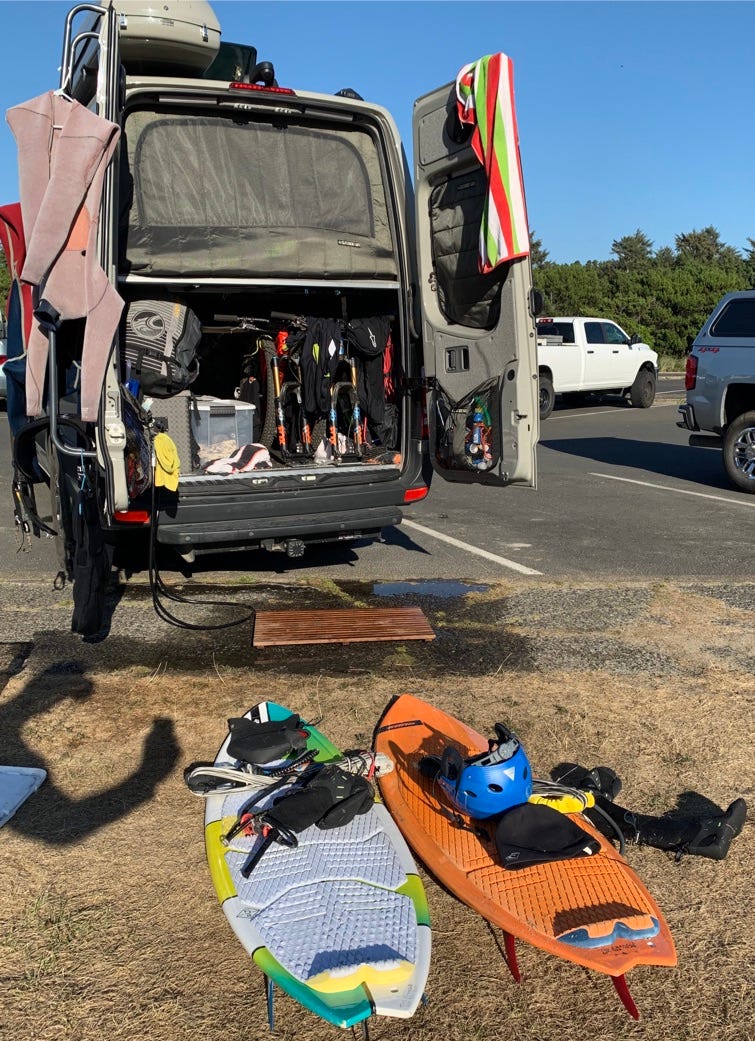
Outdoor Shower — You can have your water tank and heater configured to enable a hose for warm outdoor showers off the back of your van. This is a great option and you can shower in beautiful settings. For privacy, you can get a curtain that connects the back doors and provides a large shower area. One tip is to get a teak rectangular shower "mat" so you are not standing on dirt or sand.
Toilet — Probably the biggest debate is around indoor toilets. It would be nice to have a toilet for privacy and convenience but there are tradeoffs. They involve complicated plumbing, take up valuable space and can be smelly. An alternative is to buy a Thetford portable toilet for $200 that you can take in and out of the vehicle. Friends who do more urban camping find these useful. We own one but have never used it for the reasons mentioned above. RVs are better suited for this convenience. Kristen at Bearfoot Theory has owned a van with a toilet and a second van without one and wrote a good post on this topic. For another perspective, here is a review of a compost toilet that works well for the owners of Far Out Ride.
Separate AC unit — A luxury with drawbacks. This depends on where you plan to travel. We have an AC unit (12V 13K BTU) and not sure we would do again. We have found the normal van dash AC works fine for cooling the vehicle while driving, even while it is 100 degrees outside. The primary use cases for extra AC are 1) you are in a hot area and want to cool down for sleeping when the engine is not running, 2) you have a dog staying in van while you are out doing activities and it is hot, 3) it is blistering hot outside when you start your drive and the normal dash AC has trouble cooling the van, 4) you live in a very hot area and need it frequently. The issues are 1) the AC unit takes up roof space that will impact your roof storage (this is actually a big deal as an AC unit impacts location of solar, fans and storage up top), 2) AC consumes a lot of power and 3) the extra AC unit is expensive. If you are off the grid, you can usually only get a few hours of full cooling from your batteries so you have to use selectively. If you are plugged in, it can go all night. If you think you will frequently be in areas that are hot at night, and you will have access to electricity, then AC would be great. If you are mostly in areas with cool evenings, not sure it is worth it. I must admit that while we might not get again, the days we have used AC we really needed it (eg, 100 degree days in Hood River or Sedona w/ dog). It's a tough call.
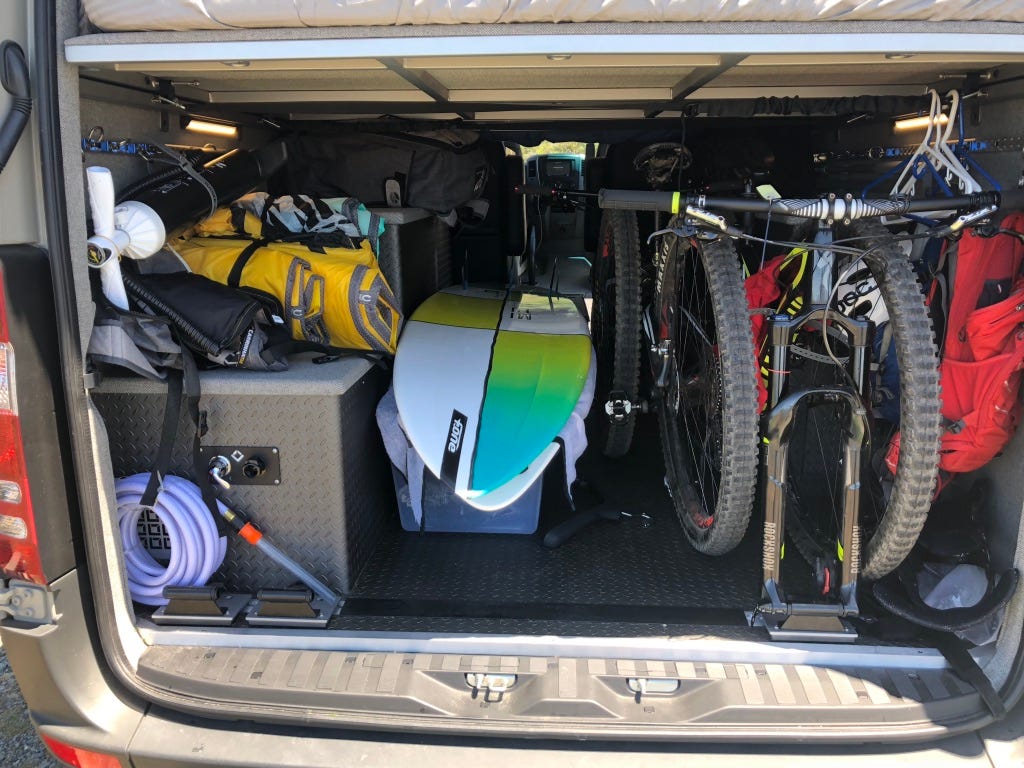
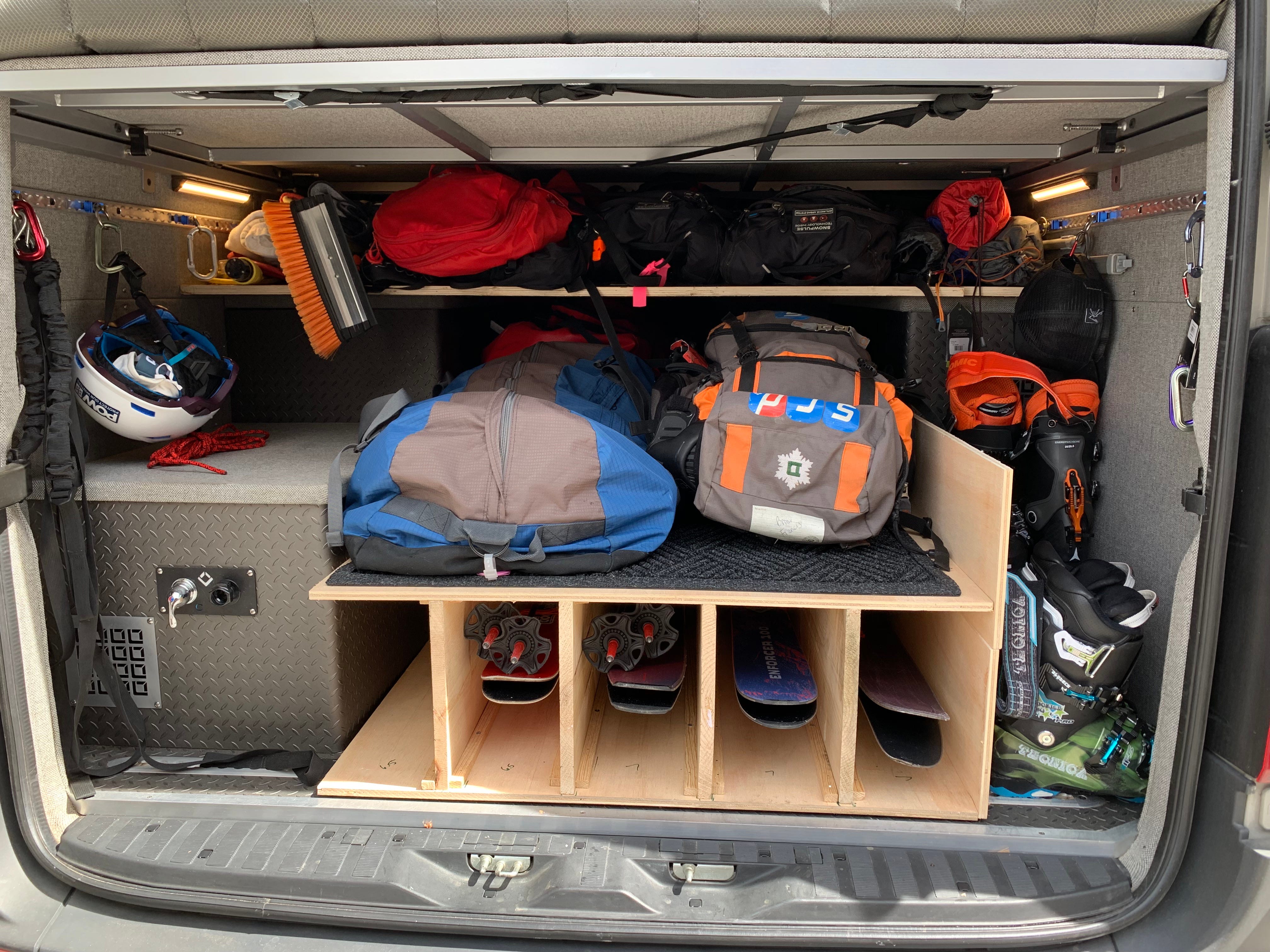
Gear Storage — This is the reason many want an adventure van. It is so nice to know all your gear is inside your vehicle safe from thieves and weather. You will always want more room for storage. Think about your primary use cases and design for that. We like having our gear below the bed platform and open to the back door. Our space is optimized for bikes, kiting gear and skis. It was critical we could fit 4 bikes in our van and still have room for other gear. We have different configurations for each season. Also good to have L track along each wall and floor to install holds, strap things down or hang gear from. There are storage features you can install to serve your primary needs. For example, some cyclists have trays that roll in/out for their bikes. We built a storage system for ski touring that accommodates skis, boots, packs, etc. The whole storage area is really worth thinking through. One tip, be careful about permanent storage systems as you will likely have many use cases to accommodate. One way to expand your storage is to have your bed removable. In the gear storage area, I would encourage the most durable material on all surfaces as the gear garage gets a lot of abuse.
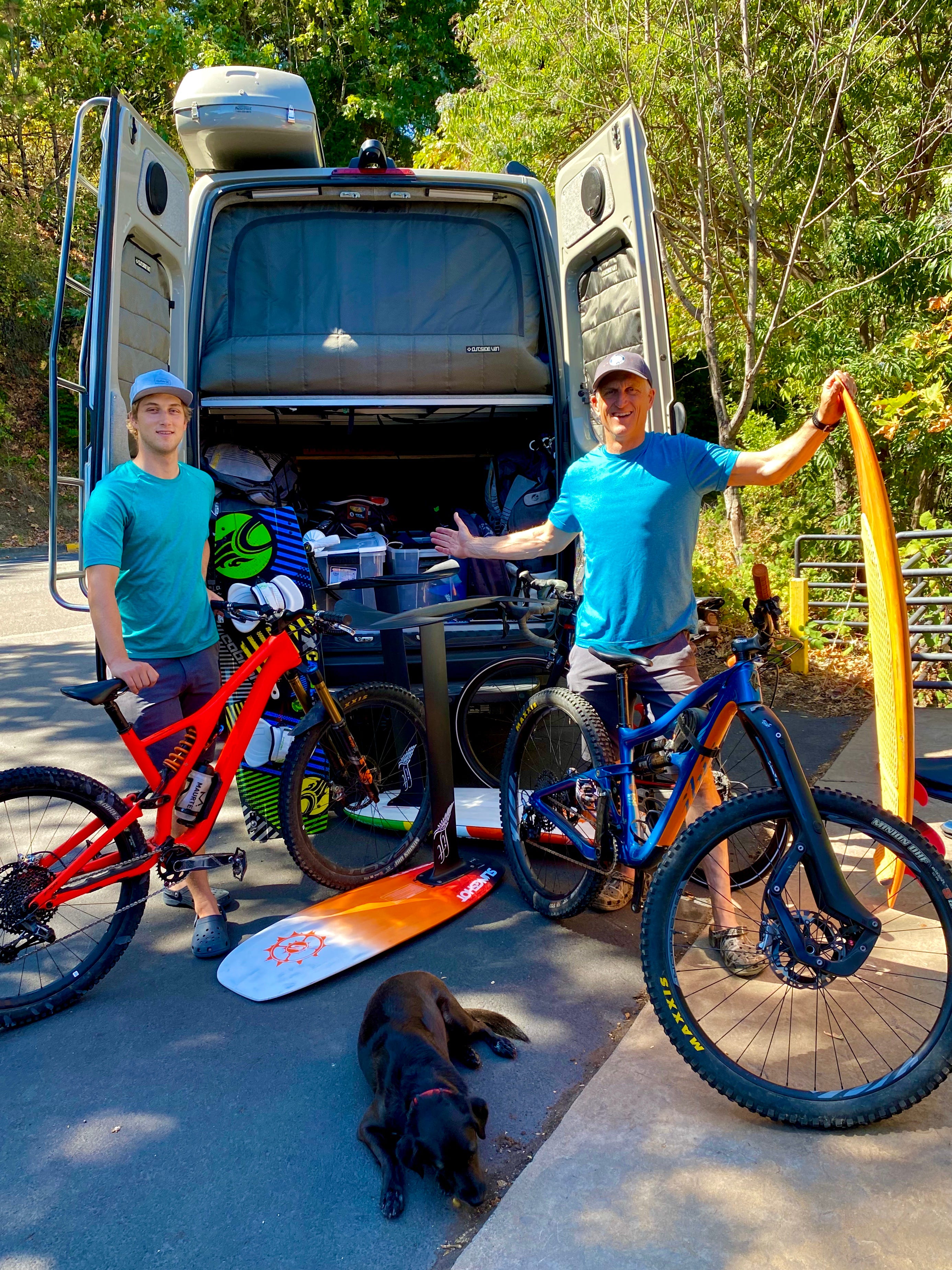
L track/Mac Track and storage mounts — It is nice to have L track throughout the van so you can put in mounting points for straps or carabiners for storage. We installed some buttons on the ceiling so we could strap a long surfboard to the ceiling indoors or strapping down extra bikes in the cabin.
Lighting — It's nice to have inset LED lights that do not draw much power. Ideally, lights for the cooking area and main cabin are separate from the lights over the sleeping area. An added feature are lights that can dim in the main cabin. It is nice if you can turn on the main cabin lights from multiple spots such as the side door (main entry), the driver dashboard and in the back where you sleep. We also appreciate dedicated lights in our gear storage, over the galley and over the storage area above the driver area. We missed, but would suggest, having a small light just for the back sleeping area.
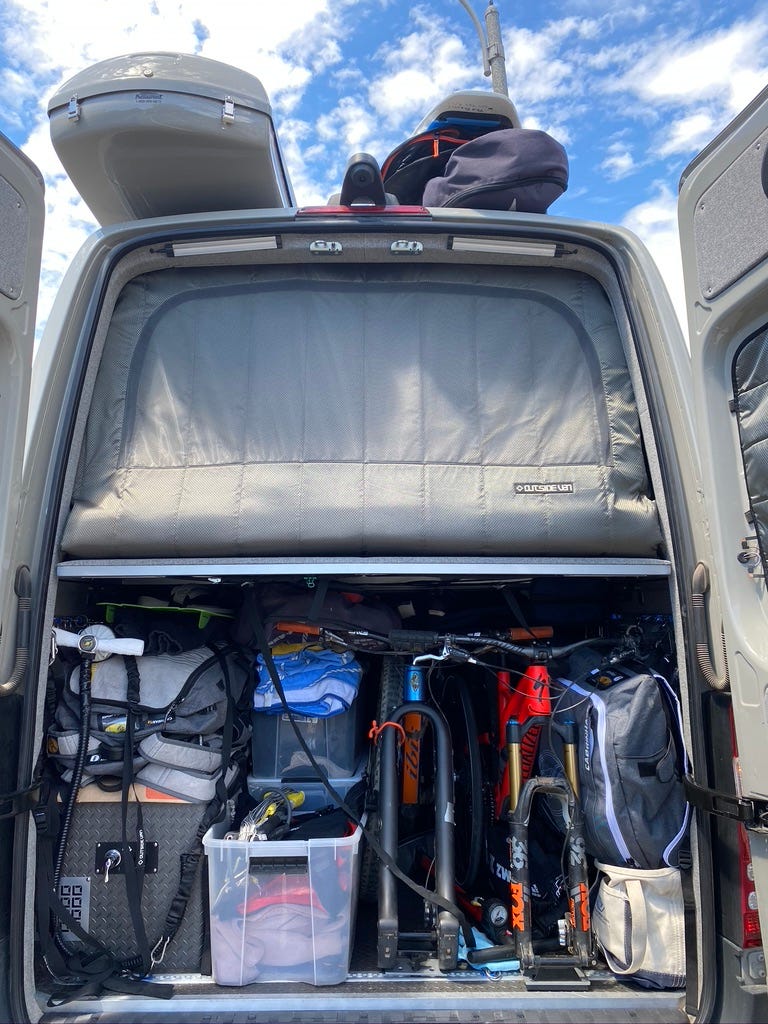
Privacy Curtains — We have insulated, removable privacy screens between the back of our bed and the outdoors and between our gear storage and our main cabin. Both are great. The one off the back allows one person to open the back doors and access gear while another person might be inside sleeping or changing. It also is insulation from the weather so you are not heating or cooling against outdoor elements. The curtain between the gear storage and cabin helps separate your garage from your living space. The gear area gets dirty quickly so this gives a little separation. It also helps with indoor climate management as there is no need to heat or cool the gear space under your bed. And if the backdoors are open, the cold (or hot) weather outside does not come into the main cabin. Last, it helps manage odor that may happen with wet wetsuits, greasy bikes, etc. Both are easy to remove so you can get the views out the back or want to open up the storage in the back.
Awning— An awning provides sun protection for your living space centered around your open side door and kitchen. We usually put down a tarp and mat and have the awning over the top. It was one of the less expensive, high value options to get. I do encourage getting one that attaches to the side of the van in case wind comes up. I have heard of awnings that just come out from the top of the van and are too flexible.
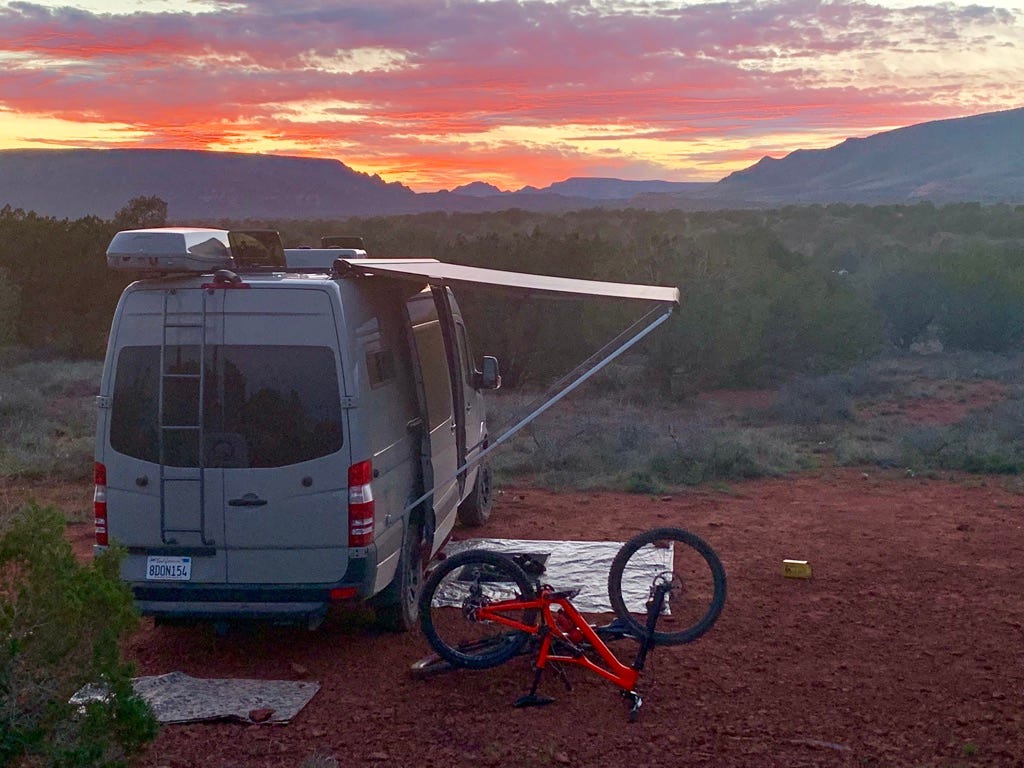
Tires, Wheels and Suspension — The factory suspension is not designed for the extra weight your build and gear will add to the van. When we bought our van, it had factory tires and suspension. It drove OK but was soft around turns and bumps. We contacted Van Compass and purchased their Sprinter suspension upgrade that includes Fox shocks and leaf springs. This provides a much improved ride and elevated the van a couple inches. We also upgraded the tires (BF Goodrich All Terrain TA 265/70/R18) and wheels (Black Rhino) to handle the extra weight. Be careful as many wheels and tires are not designed for the weight of these vans. These changes have made a huge difference in the performance and comfort driving our van.
What would we do differently?
- Roof configuration — Would have only one fan instead of two. This would allow us to have more gear storage on our roof. One fan is enough with at least two side windows to get the circulation you need. I would look into a cargo box with built in solar to free up more roof space (this was not available when we built our van).
- AC — still not sure about AC for reasons above. If we did not have AC, it would free up the roof for more storage.
- Would incorporate more color into the interior finish and fabrics.
Important stuff that is easy to overlook
- The whole roof design and how fans, AC and solar impact potential storage options. This is hard to configure and makes a difference on how much gear you can take.
- Air circulation in the van — windows and fan(s) are key
- Window coverings — we are always putting these up or taking down. Get coverings that work well and easy to use.
- Separate alternator for power generation that charges batteries quicker while driving which enable smaller solar install
- Tires, wheels and suspension make a big difference, per above
- Privacy curtains between bed and outside and insulated curtain between gear storage and main cabin
Other Resources —A good resource for van info is Bearfoot Theory. Kristen lives in her van much of the year and has written many posts on van life. Far Out Ride is another website on van life and van building. This couple lives in their van and provide detail on their van build and reviews of products they have used.
Hope this is helpful.
Van With Four Captain Chairs, Toilet in Back, Murphy Bed
Source: https://www.outsidevan.com/what-weve-learned-after-three-years-with-an-adventure-van-2020-10-12/
0 Response to "Van With Four Captain Chairs, Toilet in Back, Murphy Bed"
Post a Comment